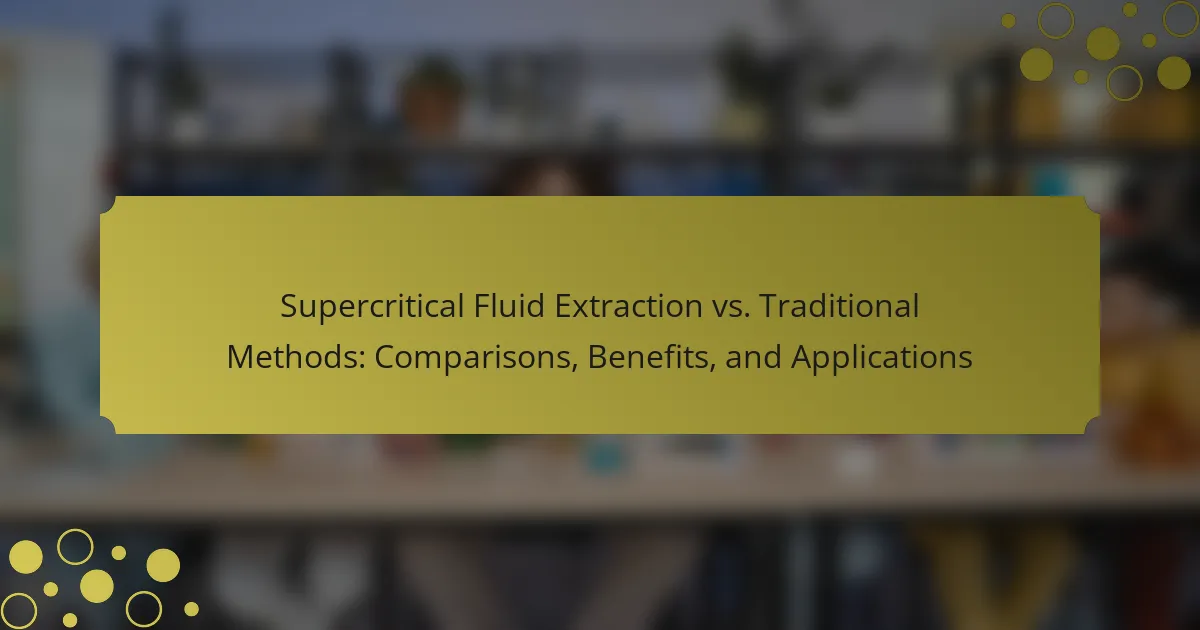Supercritical Fluid Extraction (SFE) is a technique employed in the food industry to extract valuable compounds from raw materials using supercritical fluids, primarily carbon dioxide. This method is advantageous for preserving the quality of extracts, as it operates at lower temperatures, minimizing thermal degradation and enhancing the stability of flavors, aromas, and bioactive compounds. SFE is increasingly utilized for producing essential oils, natural flavors, and antioxidants, yielding higher purity extracts while extending shelf life by reducing oxidation and microbial growth. Safety considerations are critical in SFE processes, involving careful management of high pressure and temperature, regular equipment inspections, and proper operator training to mitigate risks associated with flammable solvents.

What is Supercritical Fluid Extraction in the Food Industry?
Supercritical Fluid Extraction (SFE) is a technique used in the food industry to extract compounds from raw materials. It utilizes supercritical fluids, typically carbon dioxide, which exhibit unique properties. In the supercritical state, the fluid has both gas-like and liquid-like characteristics. This allows for efficient extraction of flavors, aromas, and bioactive compounds. SFE is favored for its ability to preserve the quality of extracted materials. It operates at lower temperatures compared to traditional methods, minimizing thermal degradation. Studies have shown that SFE can yield higher purity extracts. This method is increasingly used for essential oils, natural flavors, and antioxidants in food processing.
How does Supercritical Fluid Extraction work?
Supercritical Fluid Extraction (SFE) uses supercritical fluids to extract compounds from materials. A supercritical fluid is a substance at a temperature and pressure above its critical point. This state combines properties of both gas and liquid, allowing it to penetrate materials effectively. During SFE, the supercritical fluid dissolves target compounds while leaving behind unwanted materials. Carbon dioxide is commonly used due to its low toxicity and easy removal after extraction.
The process involves three main steps: pressurizing the fluid, passing it through the material, and then depressurizing to separate the extracted compounds. Research shows that SFE can achieve higher extraction yields and purities compared to traditional methods. Studies indicate that using supercritical CO2 can extract essential oils and flavors without degrading sensitive components.
What are the key components of Supercritical Fluid Extraction?
The key components of Supercritical Fluid Extraction (SFE) are the supercritical fluid, extraction chamber, and temperature and pressure control systems. The supercritical fluid, often carbon dioxide, acts as the primary solvent. It possesses unique properties that allow it to extract compounds efficiently. The extraction chamber is where the material and supercritical fluid interact. This chamber must withstand high pressure and temperature. Temperature and pressure control systems regulate the conditions to optimize extraction efficiency. These components work together to ensure effective extraction of desired compounds from various materials.
How do temperature and pressure affect Supercritical Fluid Extraction?
Temperature and pressure significantly influence Supercritical Fluid Extraction (SFE). Higher temperatures typically increase the solubility of compounds in the supercritical fluid. This leads to enhanced extraction efficiency. Conversely, increased pressure raises the density of the supercritical fluid. A denser fluid can dissolve more solutes, improving extraction rates.
For example, research shows that adjusting temperature and pressure optimally can maximize yield and selectivity in SFE processes. Studies indicate that specific temperature ranges between 30°C to 80°C and pressures from 100 to 300 bar are effective for various applications. These parameters allow for the extraction of a wide range of compounds from different matrices in the food industry.
What are the advantages of using Supercritical Fluid Extraction in food processing?
Supercritical Fluid Extraction (SFE) offers several advantages in food processing. It provides high extraction efficiency due to the unique properties of supercritical fluids. SFE uses carbon dioxide, which is non-toxic and leaves no harmful residues. This method preserves the quality and integrity of sensitive compounds. It operates at lower temperatures, reducing thermal degradation of heat-sensitive materials. SFE is also environmentally friendly, minimizing the use of organic solvents. Furthermore, it allows for selective extraction of desired components, enhancing product quality. Studies indicate that SFE can yield higher concentrations of bioactive compounds compared to traditional methods.
How does Supercritical Fluid Extraction compare to traditional extraction methods?
Supercritical Fluid Extraction (SFE) offers distinct advantages over traditional extraction methods. SFE uses supercritical fluids, commonly carbon dioxide, to extract compounds efficiently. This method operates at lower temperatures, preserving sensitive compounds. In contrast, traditional methods often involve high heat, which can degrade quality. SFE is also more environmentally friendly, as it uses fewer solvents. Traditional methods may rely on organic solvents, posing health and environmental risks. Additionally, SFE can achieve higher extraction yields in less time compared to traditional techniques. Research shows that SFE can extract essential oils with greater purity and potency than conventional methods.
What specific benefits does Supercritical Fluid Extraction provide for food quality?
Supercritical Fluid Extraction (SFE) enhances food quality by preserving volatile compounds. It minimizes thermal degradation of sensitive nutrients. SFE uses carbon dioxide, which is non-toxic and leaves no harmful residues. This method extracts pure flavors and essential oils effectively. Research shows that SFE maintains higher antioxidant activity in extracts compared to traditional methods. For instance, a study published in the Journal of Food Science demonstrated that SFE preserved 90% of the original flavor profile in herbs. Additionally, SFE results in higher yields of bioactive compounds. This extraction technique also reduces processing time, which helps maintain the freshness of food products.

What safety considerations are associated with Supercritical Fluid Extraction?
Safety considerations associated with Supercritical Fluid Extraction (SFE) include high pressure and temperature management. SFE operates under conditions that can lead to equipment failure if not properly monitored. The use of flammable solvents, like carbon dioxide, necessitates fire safety protocols. Additionally, the closed-loop system must be regularly inspected to prevent leaks. Operators should be trained in handling high-pressure systems to mitigate risks. Proper ventilation is essential to avoid the buildup of hazardous gases. Personal protective equipment is recommended to ensure operator safety. These measures collectively enhance the safety of SFE processes in the food industry.
What are the potential risks involved in Supercritical Fluid Extraction?
The potential risks involved in Supercritical Fluid Extraction (SFE) include high pressure and temperature hazards. These conditions can lead to equipment failure if not properly managed. There is also a risk of flammable solvents, which can create fire hazards. Additionally, improper handling of supercritical fluids may result in exposure to toxic substances. The process can also lead to the degradation of sensitive compounds if not carefully controlled. Furthermore, the complexity of the equipment requires skilled operators to minimize risks. According to research published in the Journal of Food Engineering, failure to adhere to safety protocols can increase the likelihood of accidents during SFE.
How can these risks be mitigated in food processing?
Risks in food processing can be mitigated through stringent quality control measures. Implementing Hazard Analysis and Critical Control Points (HACCP) ensures systematic monitoring of food safety. Regular training for staff on food safety protocols reduces human error. Utilizing advanced technology, such as supercritical fluid extraction, minimizes chemical residue and enhances product purity. Conducting routine equipment maintenance prevents contamination from faulty machinery. Adhering to regulatory standards ensures compliance and reduces liability. Continuous testing of raw materials and final products guarantees safety and quality. These practices collectively enhance the overall safety of food processing operations.
What safety regulations govern Supercritical Fluid Extraction in the food industry?
Safety regulations governing Supercritical Fluid Extraction (SFE) in the food industry primarily include guidelines from the Food and Drug Administration (FDA) and the Environmental Protection Agency (EPA). The FDA ensures that food products extracted using SFE meet safety and quality standards. The regulations require that any solvents used in the extraction process are recognized as safe for food applications. The EPA regulates the environmental impact of SFE processes, especially concerning the use of carbon dioxide as a solvent. Compliance with the Hazard Analysis and Critical Control Points (HACCP) system is also mandated to identify and mitigate potential hazards in the extraction process. Additionally, Good Manufacturing Practices (GMP) must be followed to ensure product safety. These regulations collectively aim to ensure that SFE processes do not compromise food safety or quality.
How can operators ensure the safety of Supercritical Fluid Extraction processes?
Operators can ensure the safety of Supercritical Fluid Extraction (SFE) processes by implementing strict safety protocols. Regular equipment maintenance is essential to prevent leaks and malfunctions. Operators should conduct thorough risk assessments prior to starting any extraction process. Proper training for staff on safety procedures is crucial to minimize human error. Utilizing high-quality materials and components can enhance system integrity. Monitoring pressure and temperature continuously ensures that they remain within safe limits. Emergency shutdown systems should be in place to mitigate risks during unforeseen events. Following industry regulations and standards further enhances safety measures in SFE operations.
What best practices should be followed during Supercritical Fluid Extraction?
Best practices during Supercritical Fluid Extraction (SFE) include optimizing temperature and pressure conditions. Maintaining appropriate solvent flow rates is crucial for efficiency. Regularly calibrating equipment ensures accurate measurements. Selecting the right solvent enhances extraction yield and quality. Monitoring extraction time prevents degradation of sensitive compounds. Implementing safety measures protects operators from high-pressure hazards. Lastly, conducting trials helps refine the extraction process for specific materials. These practices are supported by studies highlighting improved extraction efficiency and product quality.
What training is necessary for personnel involved in Supercritical Fluid Extraction?
Personnel involved in Supercritical Fluid Extraction (SFE) require specialized training in various areas. Training should cover the principles of supercritical fluids and their properties. Personnel must understand the equipment used in SFE processes. Knowledge of safety protocols is crucial due to the high pressures and temperatures involved. Training also includes handling solvents and understanding chemical interactions. Familiarity with quality control measures is necessary to ensure product integrity. Additionally, personnel should receive training in regulatory compliance related to food safety. This comprehensive training ensures safe and effective operation within the food industry.

How does Supercritical Fluid Extraction preserve food quality?
Supercritical Fluid Extraction (SFE) preserves food quality by using supercritical fluids, typically carbon dioxide, to extract compounds without high temperatures. This process minimizes thermal degradation of sensitive compounds. SFE retains flavors, aromas, and nutrients more effectively than conventional methods. The low temperatures help maintain the integrity of volatile compounds. Research shows that SFE can extract essential oils and bioactive compounds while maintaining their stability. Studies indicate that SFE can increase the yield of antioxidants in food products. This method enhances shelf life by reducing oxidation and microbial growth. Overall, SFE is an effective technique for preserving the quality of food products.
What impact does Supercritical Fluid Extraction have on flavor and aroma compounds?
Supercritical Fluid Extraction (SFE) significantly enhances the extraction of flavor and aroma compounds. SFE utilizes supercritical CO2, which effectively dissolves non-polar compounds. This method selectively extracts desirable flavor compounds while minimizing undesirable ones. Studies show that SFE preserves the volatile nature of aroma compounds better than traditional methods. For instance, a study published in the Journal of Agricultural and Food Chemistry demonstrated that SFE retains over 90% of essential oil components from herbs. This preservation leads to a more intense flavor profile in the final product. Additionally, SFE operates at lower temperatures, reducing thermal degradation of sensitive compounds. Overall, SFE is a superior method for obtaining high-quality flavor and aroma profiles in food products.
How does Supercritical Fluid Extraction affect the nutritional value of food?
Supercritical Fluid Extraction (SFE) can enhance the nutritional value of food by preserving bioactive compounds. SFE uses supercritical fluids, typically carbon dioxide, to extract essential nutrients without degrading them. This method reduces thermal degradation, which can occur in conventional extraction methods. Studies indicate that SFE retains higher levels of antioxidants, vitamins, and essential fatty acids. For example, research published in the “Journal of Agricultural and Food Chemistry” shows that SFE extracts more polyphenols from fruits compared to traditional methods. Therefore, SFE not only maintains but can also improve the nutritional profile of food products.
What role does Supercritical Fluid Extraction play in extending shelf life?
Supercritical Fluid Extraction (SFE) helps extend shelf life by efficiently removing volatile compounds and contaminants from food products. This process reduces oxidation and microbial growth, which are key factors in spoilage. SFE utilizes supercritical fluids, often carbon dioxide, to extract essential oils and active compounds without high temperatures. Maintaining lower temperatures preserves the integrity of heat-sensitive nutrients. Research shows that SFE can significantly enhance the stability of oils, herbs, and other food ingredients. A study by Chemat et al. (2017) confirms that SFE improves the antioxidant properties of extracted compounds, contributing to longer shelf life.
What are the common applications of Supercritical Fluid Extraction in the food industry?
Supercritical Fluid Extraction (SFE) is commonly applied in the food industry for extracting flavor compounds, essential oils, and bioactive ingredients. SFE is efficient in preserving the quality and integrity of sensitive compounds. It is used to extract caffeine from coffee beans, resulting in decaffeinated coffee. The technique also extracts carotenoids and polyphenols from fruits and vegetables. Additionally, SFE is employed in producing natural food preservatives and antioxidants. Studies indicate that SFE minimizes thermal degradation, thus maintaining nutritional value. This method is favored for its environmentally friendly profile, using less solvent and energy compared to traditional extraction methods.
Which food products benefit most from Supercritical Fluid Extraction?
Supercritical Fluid Extraction (SFE) is particularly beneficial for extracting essential oils, flavors, and bioactive compounds from food products. Common food products that benefit include herbs, spices, and coffee beans. SFE preserves the quality of these products by minimizing thermal degradation. It also enhances the extraction efficiency compared to traditional methods. Studies show that SFE can yield higher concentrations of active compounds. For instance, the extraction of caffeine from coffee beans is more effective with SFE. Additionally, the method is environmentally friendly, using less solvent. These factors make SFE an ideal choice for food product extraction.
How is Supercritical Fluid Extraction utilized in flavor and fragrance industries?
Supercritical Fluid Extraction (SFE) is utilized in the flavor and fragrance industries to efficiently extract essential oils and aromatic compounds. SFE uses supercritical carbon dioxide as a solvent, which allows for selective extraction without leaving harmful residues. This method preserves the integrity of delicate compounds better than traditional extraction methods. SFE operates at lower temperatures, reducing thermal degradation of heat-sensitive flavors and fragrances. Studies show that SFE can yield higher purity and concentration of extracts compared to other techniques. Additionally, it offers a sustainable alternative by minimizing solvent use and waste. The method’s ability to tune solubility by adjusting pressure and temperature enhances its versatility in extracting a wide range of compounds.
What tips can ensure successful implementation of Supercritical Fluid Extraction?
To ensure successful implementation of Supercritical Fluid Extraction (SFE), it is crucial to optimize extraction parameters. Key parameters include temperature, pressure, and solvent flow rate. Properly selecting the solvent enhances the extraction efficiency. Using a suitable supercritical fluid, like carbon dioxide, is vital due to its non-toxic nature and tunable properties. Maintaining consistent temperature and pressure during extraction is essential for reproducibility. Regularly calibrating equipment ensures accurate measurements. Additionally, pre-treating raw materials can improve extraction yield. Employing a closed-loop system minimizes solvent loss and enhances sustainability. These practices collectively contribute to effective SFE in the food industry.
How can food manufacturers optimize their Supercritical Fluid Extraction processes?
Food manufacturers can optimize their Supercritical Fluid Extraction (SFE) processes by adjusting parameters such as pressure, temperature, and solvent flow rate. These adjustments enhance extraction efficiency and yield. For instance, increasing pressure generally improves solubility of target compounds, while higher temperatures can enhance mass transfer rates.
Additionally, using co-solvents can improve the extraction of polar compounds. Research indicates that the use of ethanol as a co-solvent significantly increases the extraction yield of essential oils. Manufacturers should also consider the particle size of raw materials; smaller particles increase surface area and improve extraction rates.
Regular maintenance of extraction equipment ensures consistent performance and minimizes downtime. Implementing process monitoring technologies can provide real-time data, allowing for immediate adjustments to optimize extraction conditions. These strategies collectively enhance the overall efficiency and effectiveness of SFE in food manufacturing.
What troubleshooting strategies can be employed during Supercritical Fluid Extraction?
Common troubleshooting strategies during Supercritical Fluid Extraction (SFE) include adjusting temperature and pressure settings. These parameters significantly influence the solubility of the target compounds. If extraction yields are low, increasing the pressure can enhance the extraction efficiency. Conversely, if the extraction is too slow, lowering the temperature may help improve the process.
Another strategy is to optimize the solvent flow rate. A flow rate that is too high can lead to poor extraction, while a rate that is too low may prolong the process unnecessarily. Additionally, monitoring the particle size of the material being extracted is crucial. Smaller particle sizes generally increase the surface area, enhancing extraction efficiency.
Regular maintenance of the extraction equipment is also essential. Clogged filters or worn components can impede the extraction process. Finally, conducting trials with different solvents can help identify the most effective solvent for specific target compounds. These strategies help ensure optimal performance and quality in SFE applications.
Supercritical Fluid Extraction (SFE) is a method used in the food industry to extract compounds from raw materials using supercritical fluids, mainly carbon dioxide. This technique offers advantages such as high extraction efficiency, preservation of sensitive compounds, and reduced thermal degradation, making it suitable for obtaining essential oils, flavors, and antioxidants. The article explores the working principles of SFE, its key components, safety considerations, and regulatory guidelines, while highlighting its impact on food quality, nutritional value, and shelf life. Additionally, it discusses optimization strategies and troubleshooting techniques to enhance SFE processes in food manufacturing.



